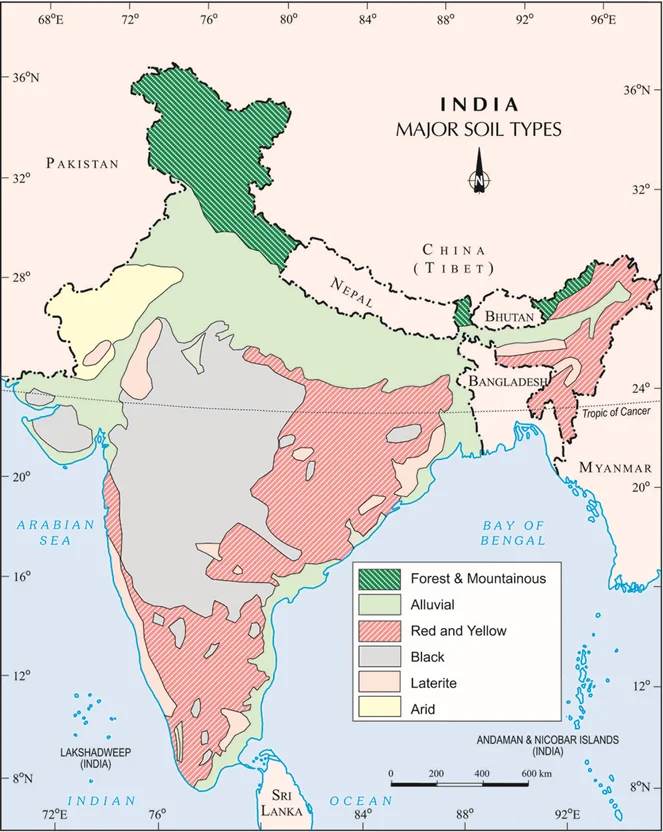-
16 Jan 2025
GS Paper 1
Geography
Day 40: Discuss the formation processes and geographical distribution of the major soil types in India. (250 Words)
Approach
- In the Introduction, explain the factors influencing soil formation.
- In the Body, detail the formation processes of soil.
- Discuss the geographical distribution of major soil types in India.
- Include relevant examples.
- Conclude by emphasizing sustainable soil management.
Introduction
Soil forms the foundation of agriculture and ecosystems, serving as a critical resource for food production and biodiversity. In India, soil formation is influenced by factors like climate, topography, parent material, time, and biological activity, resulting in diverse soil types across regions. These variations directly affect agricultural practices and crop choices.
Body
Processes of Soil Formation
- Weathering of Parent Rock:
- The disintegration of rocks through physical, chemical, or biological processes forms soil.
- Example: Alluvial soils in river basins are derived from sediments transported and deposited by rivers.
- Climatic Influence:
- Temperature, rainfall, and humidity influence soil characteristics, such as texture and fertility.
- For instance, Laterite soils are formed in high-rainfall areas due to leaching, which removes soluble nutrients.
- Organic and Biological Activity:
- The decomposition of plants and animals enriches the soil with humus and nutrients.
- Example: Black soils, formed from basaltic lava, have high organic content and moisture-retention capacity.
- Topography and Time:
- Landscape features like slopes and the time taken for weathering influence soil depth and development.
- Example: Mountain soils are shallow and poorly developed due to erosion on steep slopes.
Geographical Distribution of Major Soil Types in India
- Alluvial Soil:
- Coverage: Approximately 43% of India’s land area, primarily in the Indo-Gangetic Plain and river deltas like the Ganga, Brahmaputra, and Mahanadi.
- Characteristics: Rich in potash and phosphoric acid, but deficient in nitrogen. Highly fertile and ideal for crops like wheat, rice, and sugarcane.
- Black Soil (Regur Soil):
- Regions: Found in Maharashtra, Madhya Pradesh, Gujarat, and Andhra Pradesh.
- Formation: Derived from volcanic basalt rocks.
- Characteristics: Retains moisture, cracks during dry seasons, and is well-suited for cotton cultivation.
- Red and Yellow Soil:
- Regions: Common in Odisha, Chhattisgarh, southern Karnataka, and Jharkhand.
- Formation: Weathering of crystalline and metamorphic rocks.
- Characteristics: Rich in iron oxide, giving it a reddish hue, but deficient in nitrogen and phosphorus. Suitable for crops like millets and groundnuts.
- Laterite Soil:
- Regions: Found in Kerala, Karnataka, Tamil Nadu, and parts of Maharashtra.
- Formation: Intense leaching in hot, wet climates.
- Characteristics: Poor in nutrients but suitable for tea, coffee, and cashew plantations when managed well.
- Arid and Desert Soil:
- Regions: Covers parts of Rajasthan, Gujarat, and Haryana.
- Formation: Sandy soils formed due to wind erosion and arid climatic conditions.
- Characteristics: Low fertility and high salinity, requiring irrigation for cultivation. Suitable for crops like barley and millet.
- Mountain Soil:
- Regions: Found in the Himalayas and parts of the Western and Eastern Ghats.
- Formation: Formed by weathering of rocks on steep slopes.
- Characteristics: Shallow and acidic, ideal for horticulture and plantation crops like apples and tea.
- Peaty and Marshy Soil:
- Regions: Found in Kerala, West Bengal, and coastal regions.
- Formation: Accumulation of organic matter in waterlogged areas.
- Characteristics: Rich in humus but often saline and acidic.
Conclusion
The diversity of soils in India reflects the country’s complex geographical and climatic variations. These soils are crucial for supporting India’s agriculture-dependent economy. To ensure soil health and productivity, sustainable practices like organic farming, afforestation, and erosion control must be adopted. Effective soil management is essential for achieving long-term food security and ecological balance.





